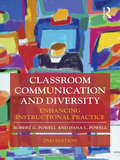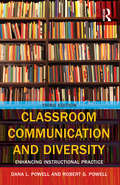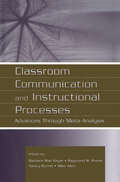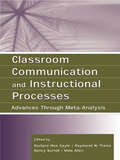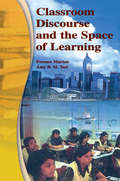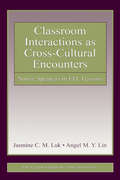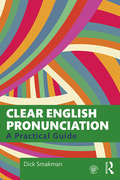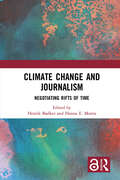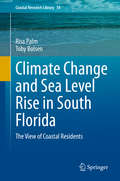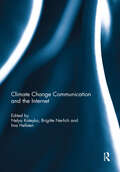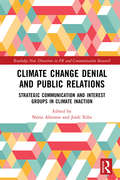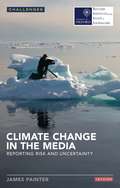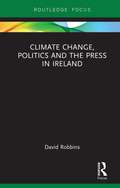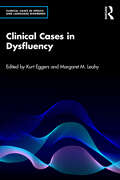- Table View
- List View
Classroom Communication and Diversity: Enhancing Instructional Practice
by Robert G. Powell Dana L. PowellClassroom Communication and Diversity is an integral resource for teaching awareness of diversity issues and communication in the classroom. Drawing on the research in the communication and education disciplines, authors Robert G. Powell and Dana Caseau provide theoretical models and useful strategies for improving instructional practices. They address the ways in which culture influences communication in the classroom, and assist teachers in developing the skills necessary to meet the needs of the students in their classrooms. New to the second edition is an expanded skills component, additional teaching resources, and an increased focus on the role of diversity in the classroom. Much of the information shared in this text derives from the authors' research and experience in schools and from the experiences of others, including teachers, parents, and children. Their experiences, combined with the cross-disciplinary approach, produce a volume of unique perspectives and considerable insight.
Classroom Communication and Diversity: Enhancing Instructional Practice (Routledge Communication Series)
by Robert G. Powell Dana L. PowellClassroom Communication and Diversity provides a useful framework for helping both new and experienced teachers and instructors navigate the communication challenges in today’s diverse classroom. It encourages teachers to reflect on how their personal cultures influence their expectations regarding classroom communication. This textbook is distinctive in its distillation of research from numerous sources to provide the best viewpoint and systems for focusing on the needs of the individual learner. Dana L. Powell and Robert G. Powell draw on research in both the communication and education disciplines, and provide useful strategies for improving teaching practices alongside theoretical models regarding diversity in the classroom. Much of the information found in this text is also inspired by the authors’ direct experience in schools and from the experience they have gleaned from other first-line instructors as well as from parents and children. Among the many updates to this Third Edition are: Expanded coverage of students with diverse needs Discussion on working effectively with parents Coverage of cultural influences and the impact of race and ethnicity on disciplinary actions Examination of the role of social media and its impact on instructional communication The increase of educational technology use. Teachers and scholars in the communication and education fields will find this text practical and valuable for their teaching efforts, and it is appropriate for instructional communication courses in both disciplines.
Classroom Communication and Diversity: Enhancing Instructional Practice (Routledge Communication Series)
by Robert G. Powell Dana L. PowellClassroom Communication and Diversity provides a useful framework for helping both new and experienced teachers and instructors navigate the communication challenges in today’s diverse classroom. It encourages teachers to reflect on how their personal cultures influence their expectations regarding classroom communication. This textbook is distinctive in its distillation of research from numerous sources to provide the best viewpoint and systems for focusing on the needs of the individual learner. Dana L. Powell and Robert G. Powell draw on research in both the communication and education disciplines, and provide useful strategies for improving teaching practices alongside theoretical models regarding diversity in the classroom. Much of the information found in this text is also inspired by the authors’ direct experience in schools and from the experience they have gleaned from other first-line instructors as well as from parents and children. Among the many updates to this Third Edition are: Expanded coverage of students with diverse needs Discussion on working effectively with parents Coverage of cultural influences and the impact of race and ethnicity on disciplinary actions Examination of the role of social media and its impact on instructional communication The increase of educational technology use. Teachers and scholars in the communication and education fields will find this text practical and valuable for their teaching efforts, and it is appropriate for instructional communication courses in both disciplines.
Classroom Communication and Instructional Processes: Advances Through Meta-Analysis
by Barbara Mae Gayle Raymond W. Preiss Nancy Burrell Mike AllenThis volume offers a systematic review of the literature on communication education and instruction. Making meta-analysis findings accessible and relevant, the editors of this volume approach the topic from the perspective that meta-analysis serves as a useful tool for summarizing experiments and for determining how and why specific teaching and learning experiences have positive student outcomes. The topics covered here are meaningful and relevant to classroom practice, and each chapter offers a summary of existing quantitative social science research using meta-analysis. With contributions from experienced researchers throughout the communication discipline, this work provides a unique analysis of research in instructional communication.Taken together, the chapters in this volume enhance understanding of behaviors, practices, and processes that promote positive student outcomes. This book is a must-read for scholars, graduate students, and researchers in communication education, and will also be of interest to scholars and researchers in education.
Classroom Communication and Instructional Processes: Advances Through Meta-Analysis
by Barbara Mae Gayle Raymond W. Preiss Nancy Burrell Mike AllenThis volume offers a systematic review of the literature on communication education and instruction. Making meta-analysis findings accessible and relevant, the editors of this volume approach the topic from the perspective that meta-analysis serves as a useful tool for summarizing experiments and for determining how and why specific teaching and learning experiences have positive student outcomes. The topics covered here are meaningful and relevant to classroom practice, and each chapter offers a summary of existing quantitative social science research using meta-analysis. With contributions from experienced researchers throughout the communication discipline, this work provides a unique analysis of research in instructional communication.Taken together, the chapters in this volume enhance understanding of behaviors, practices, and processes that promote positive student outcomes. This book is a must-read for scholars, graduate students, and researchers in communication education, and will also be of interest to scholars and researchers in education.
Classroom Discourse and the Space of Learning
by Ference Marton Amy B.M. Tsui Pakey P.M. Chik Po Yuk Ko Mun Ling LoClassroom Discourse and the Space of Learning is about learning in schools and the central role of language in learning. The investigations of learning it reports are based on two premises: First, whatever you are trying to learn, there are certain necessary conditions for succeeding--although you cannot be sure that learning will take place when those conditions are met, you can be sure that no learning will occur if they are not. The limits of what is possible to learn is what the authors call "the space of learning." Second, language plays a central role in learning--it does not merely convey meaning, it also creates meaning. The book explicates the necessary conditions for successful learning and employs investigations of classroom discourse data to demonstrate how the space of learning is linguistically constituted in the classroom.Classroom Discourse and the Space of Learning:*makes the case that an understanding of how the space of learning is linguistically constituted in the classroom is best achieved through investigating "classroom discourse" and that finding out what the conditions are for successful learning and bringing them about should be the teacher's primary professional task. Thus, it is fundamentally important for teachers and student teachers to be given opportunities to observe different teachers teaching the same thing, and to analyze and reflect on whether the classroom discourse in which they are engaged maximizes or minimizes the conditions for learning;*is both more culturally situated and more generalizable than many other studies of learning in schools. Each case of classroom teaching clearly demonstrates how the specific language, culture, and pedagogy molds what is happening in the classroom, yet at the same time it is possible to generalize from these culturally specific examples the necessary conditions that must be met for the development of any specific capability regardless of where the learning is taking place and what other conditions might be present; and *encompasses both theory and practice--providing a detailed explication of the theory of learning underlying the analyses of classroom teaching reported, along with close analyses of a number of authentic cases of classroom teaching driven by classroom discourse data which have practical relevance for teachers.Intended for researchers and graduate students in education, teacher educators, and student teachers, Classroom Discourse and the Space of Learning is practice- and content-oriented, theoretical, qualitative, empirical, and focused on language, and links teaching and learning in significant new ways.
Classroom Discourse and the Space of Learning
by Ference Marton Amy B.M. Tsui Pakey P.M. Chik Po Yuk Ko Mun Ling LoClassroom Discourse and the Space of Learning is about learning in schools and the central role of language in learning. The investigations of learning it reports are based on two premises: First, whatever you are trying to learn, there are certain necessary conditions for succeeding--although you cannot be sure that learning will take place when those conditions are met, you can be sure that no learning will occur if they are not. The limits of what is possible to learn is what the authors call "the space of learning." Second, language plays a central role in learning--it does not merely convey meaning, it also creates meaning. The book explicates the necessary conditions for successful learning and employs investigations of classroom discourse data to demonstrate how the space of learning is linguistically constituted in the classroom.Classroom Discourse and the Space of Learning:*makes the case that an understanding of how the space of learning is linguistically constituted in the classroom is best achieved through investigating "classroom discourse" and that finding out what the conditions are for successful learning and bringing them about should be the teacher's primary professional task. Thus, it is fundamentally important for teachers and student teachers to be given opportunities to observe different teachers teaching the same thing, and to analyze and reflect on whether the classroom discourse in which they are engaged maximizes or minimizes the conditions for learning;*is both more culturally situated and more generalizable than many other studies of learning in schools. Each case of classroom teaching clearly demonstrates how the specific language, culture, and pedagogy molds what is happening in the classroom, yet at the same time it is possible to generalize from these culturally specific examples the necessary conditions that must be met for the development of any specific capability regardless of where the learning is taking place and what other conditions might be present; and *encompasses both theory and practice--providing a detailed explication of the theory of learning underlying the analyses of classroom teaching reported, along with close analyses of a number of authentic cases of classroom teaching driven by classroom discourse data which have practical relevance for teachers.Intended for researchers and graduate students in education, teacher educators, and student teachers, Classroom Discourse and the Space of Learning is practice- and content-oriented, theoretical, qualitative, empirical, and focused on language, and links teaching and learning in significant new ways.
Classroom Interactions as Cross-Cultural Encounters: Native Speakers in EFL Lessons (ESL & Applied Linguistics Professional Series)
by Jasmine C. Luk Angel M. LinClassroom Interactions as Cross-Cultural Encounters is about native English speakers teaching English as a global language in non-English speaking countries. Through analysis of naturally occurring dialogic encounters, the authors examine the multifaceted ways in which teachers and students utilize diverse communicative resources to construct, display, and negotiate their identities as teachers, learners, and language users, with different pedagogic, institutional, social, and political implications. A range of issues in applied linguistics is addressed, including linguistic imperialism, post-colonial theories, micropolitics of classroom interaction, language and identity, and bilingual classroom practices. Intended to help TESOL professionals of different cultural backgrounds, working in different sociocultural contexts, to critically understand how non-assimilationist, dialogic intercultultural communication with students can be achieved and built on for mutual cultural and linguistic enrichment and empowerment, this book:*emphasizes the sociocultural meanings and micropolitics of classroom interactions that reveal the complex realities of power and identity negotiations in cross-cultural interactions in ELT (English Language Teaching) classroom contexts;*revisits and reconstitutes the notion of native-speakerness and repositions the roles of native and non-native English teachers in the TESOL profession in the contexts of decolonization and globalization; *highlights the need to mobilize intercultural communicative resources for global communication;*addresses two major concerns of EFL (English as a Foreign Language) classroom researchers and teachers: student resistance and learning motivation; and*examines and analyzes the changing ideologies (both explicit and implicit) of teachers and students about English learning in the context of a post-colonial society, and how these ideologies are being enacted, reproduced, but also sometimes contested in EFL classroom interactions. Each chapter includes Questions for Reflection and Discussion to promote critical thinking and understanding of the issues discussed. Tuning-In discussion questions are provided in the three chapters on classroom data analysis to activate readers interpretive schemas before they examine the actual classroom episodes. The data are from an ethnographic study in post-colonial Hong Kong secondary schools involving four native English-speaker teachers and two bilingual Cantonese-English speaking teachers engaged in intercultural classroom dialogues with their Cantonese Hong Kong students. The rich, naturally occurring classroom data and in-depth analyses provide useful pedagogical materials for courses in EFL teacher education programs on classroom discourse analysis from sociocultural perspectives.
Classroom Interactions as Cross-Cultural Encounters: Native Speakers in EFL Lessons (ESL & Applied Linguistics Professional Series)
by Jasmine C. Luk Angel M. LinClassroom Interactions as Cross-Cultural Encounters is about native English speakers teaching English as a global language in non-English speaking countries. Through analysis of naturally occurring dialogic encounters, the authors examine the multifaceted ways in which teachers and students utilize diverse communicative resources to construct, display, and negotiate their identities as teachers, learners, and language users, with different pedagogic, institutional, social, and political implications. A range of issues in applied linguistics is addressed, including linguistic imperialism, post-colonial theories, micropolitics of classroom interaction, language and identity, and bilingual classroom practices. Intended to help TESOL professionals of different cultural backgrounds, working in different sociocultural contexts, to critically understand how non-assimilationist, dialogic intercultultural communication with students can be achieved and built on for mutual cultural and linguistic enrichment and empowerment, this book:*emphasizes the sociocultural meanings and micropolitics of classroom interactions that reveal the complex realities of power and identity negotiations in cross-cultural interactions in ELT (English Language Teaching) classroom contexts;*revisits and reconstitutes the notion of native-speakerness and repositions the roles of native and non-native English teachers in the TESOL profession in the contexts of decolonization and globalization; *highlights the need to mobilize intercultural communicative resources for global communication;*addresses two major concerns of EFL (English as a Foreign Language) classroom researchers and teachers: student resistance and learning motivation; and*examines and analyzes the changing ideologies (both explicit and implicit) of teachers and students about English learning in the context of a post-colonial society, and how these ideologies are being enacted, reproduced, but also sometimes contested in EFL classroom interactions. Each chapter includes Questions for Reflection and Discussion to promote critical thinking and understanding of the issues discussed. Tuning-In discussion questions are provided in the three chapters on classroom data analysis to activate readers interpretive schemas before they examine the actual classroom episodes. The data are from an ethnographic study in post-colonial Hong Kong secondary schools involving four native English-speaker teachers and two bilingual Cantonese-English speaking teachers engaged in intercultural classroom dialogues with their Cantonese Hong Kong students. The rich, naturally occurring classroom data and in-depth analyses provide useful pedagogical materials for courses in EFL teacher education programs on classroom discourse analysis from sociocultural perspectives.
Clear English Pronunciation: A Practical Guide
by Dick SmakmanClear English Pronunciation provides students with the tools to effectively communicate in English without centring solely on native-speaker pronunciation models. The focus of the book is on individual pronunciation targets rather than a one-size-fits-all approach. Divided into four sections, each featuring detailed articulatory explanations, sample sentences, and recordings to help learners improve their pronunciation, this book: introduces the phenomenon of pronunciation as part of a broader communicative realm; explains and demonstrates the melody and rhythm of understandable and natural English pronunciation; supports students in identifying and practicing their own pronunciation issues. Supported by an interactive companion website which features recordings and expanded explanations of key topics, Clear English Pronunciation is an essential textbook for international learners of English who want to improve their pronunciation skills in diverse social settings. https://www.universiteitleiden.nl/clearenglishpronunciation
Clear English Pronunciation: A Practical Guide
by Dick SmakmanClear English Pronunciation provides students with the tools to effectively communicate in English without centring solely on native-speaker pronunciation models. The focus of the book is on individual pronunciation targets rather than a one-size-fits-all approach. Divided into four sections, each featuring detailed articulatory explanations, sample sentences, and recordings to help learners improve their pronunciation, this book: introduces the phenomenon of pronunciation as part of a broader communicative realm; explains and demonstrates the melody and rhythm of understandable and natural English pronunciation; supports students in identifying and practicing their own pronunciation issues. Supported by an interactive companion website which features recordings and expanded explanations of key topics, Clear English Pronunciation is an essential textbook for international learners of English who want to improve their pronunciation skills in diverse social settings. https://www.universiteitleiden.nl/clearenglishpronunciation
Climate Change and Journalism: Negotiating Rifts of Time
by Henrik BødkerThis edited collection addresses climate change journalism from the perspective of temporality, showcasing how various time scales—from geology, meteorology, politics, journalism, and lived cultures—interact with journalism around the world. Analyzing the meetings of and schisms between various temporalities as they emerge from reporting on climate change globally, Climate Change and Journalism: Negotiating Rifts of Time asks how climate change as a temporal process gets inscribed within the temporalities of journalism. The overarching question of climate change journalism and its relationship to temporality is considered through the themes of environmental justice and slow violence, editorial interventions, ecological loss, and political and religious contexts, which are in turn explored through a selection of case studies from the US, France, Thailand, Brazil, Australia, Spain, Mexico, Canada, and the UK. This is an insightful resource for students and scholars in the fields of journalism, media studies, environmental communication, and communications generally.
Climate Change and Journalism: Negotiating Rifts of Time
by Henrik Bødker Hanna E. MorrisThis edited collection addresses climate change journalism from the perspective of temporality, showcasing how various time scales—from geology, meteorology, politics, journalism, and lived cultures—interact with journalism around the world. Analyzing the meetings of and schisms between various temporalities as they emerge from reporting on climate change globally, Climate Change and Journalism: Negotiating Rifts of Time asks how climate change as a temporal process gets inscribed within the temporalities of journalism. The overarching question of climate change journalism and its relationship to temporality is considered through the themes of environmental justice and slow violence, editorial interventions, ecological loss, and political and religious contexts, which are in turn explored through a selection of case studies from the US, France, Thailand, Brazil, Australia, Spain, Mexico, Canada, and the UK. This is an insightful resource for students and scholars in the fields of journalism, media studies, environmental communication, and communications generally.
Climate Change and Sea Level Rise in South Florida: The View of Coastal Residents (Coastal Research Library #34)
by Risa Palm Toby BolsenSouth Florida is frequently cited as the part of the United State of America as most susceptible to the devastation accompanying sea level rise. Several scholarly studies have shown the negative impact of coastal location in Florida on housing values. Are the residents of South Florida concerned? Is susceptibility to sea level rise actually affecting the housing market in terms of demand, the availability of home mortgages, or house prices? Are people living at particular risk from sea level rise aware of this risk and more open to new information about climate change? Do they support policies and laws to mitigate the pace and extent of climate change? Answers to these questions are not only of general interest, but they are also key to our understanding of the human dimensions of this problem. This book describes the results of a detailed survey in which respondents viewed a local map displaying flooding to their own community that would result from a Category 3 hurricane in 2033. It discusses political party identification and ideology that has an overwhelming impact in shaping views about sea level rise and climate change. This book has enormous implications for the effectiveness of communicating risk information. The text is important if we, as a nation, are to design communication strategies that will lead to broader policy to combat or mitigate this risk.
Climate Change Communication and the Internet
by Nelya Koteyko Brigitte Nerlich Iina HellstenThe volume provides a timely, state of the art collection of studies examining climate change communication in the era of digital media. The chapters focus on a broad range of topics covering various aspects of both practice and research in climate change communication, ranging from the use of online platforms, to blogs, and social networking sites. Climate change communication has increasingly moved into Internet-based forums, and this volume provides a comprehensive overview of research into Internet and climate change communication. The studies share valuable methodological insights in this relatively new field of research and shed light on the opportunities and challenges underlying the collection and analysis of online climate change-related data. This book was previously published as a special issue of Environmental Communication.
Climate Change Communication and the Internet
by Nelya Koteyko, Brigitte Nerlich and Iina HellstenThe volume provides a timely, state of the art collection of studies examining climate change communication in the era of digital media. The chapters focus on a broad range of topics covering various aspects of both practice and research in climate change communication, ranging from the use of online platforms, to blogs, and social networking sites. Climate change communication has increasingly moved into Internet-based forums, and this volume provides a comprehensive overview of research into Internet and climate change communication. The studies share valuable methodological insights in this relatively new field of research and shed light on the opportunities and challenges underlying the collection and analysis of online climate change-related data. This book was previously published as a special issue of Environmental Communication.
Climate Change Denial and Public Relations: Strategic communication and interest groups in climate inaction (Routledge New Directions in PR & Communication Research)
by Núria Almiron Jordi XifraThis is the first book on climate change denial and lobbying that combines the ideology of denial and the role of anthropocentrism in the study of interest groups and communication strategy. Climate Change Denial and Public Relations: Strategic Communication and Interest Groups in Climate Inaction is a critical approach to climate change denial from a strategic communication perspective. The book aims to provide an in-depth analysis of how strategic communication by interest groups is contributing to climate change inaction. It does this from a multidisciplinary perspective that expands the usual approach of climate change denialism and introduces a critical reflection on the roots of the problem, including the ethics of the denialist ideology and the rhetoric and role of climate change advocacy. Topics addressed include the power of persuasive narratives and discourses constructed to support climate inaction by lobbies and think tanks, the dominant human supremacist view and the patriarchal roots of denialists and advocates of climate change alike, the knowledge coalitions of the climate think tank networks, the denial strategies related to climate change of the nuclear, oil, and agrifood lobbies, the role of public relations firms, the anthropocentric roots of public relations, taboo topics such as human overpopulation and meat-eating, and the technological myth. This unique volume is recommended reading for students and scholars of communication and public relations.
Climate Change Denial and Public Relations: Strategic communication and interest groups in climate inaction (Routledge New Directions in PR & Communication Research)
by Núria Almiron Jordi XifraThis is the first book on climate change denial and lobbying that combines the ideology of denial and the role of anthropocentrism in the study of interest groups and communication strategy. Climate Change Denial and Public Relations: Strategic Communication and Interest Groups in Climate Inaction is a critical approach to climate change denial from a strategic communication perspective. The book aims to provide an in-depth analysis of how strategic communication by interest groups is contributing to climate change inaction. It does this from a multidisciplinary perspective that expands the usual approach of climate change denialism and introduces a critical reflection on the roots of the problem, including the ethics of the denialist ideology and the rhetoric and role of climate change advocacy. Topics addressed include the power of persuasive narratives and discourses constructed to support climate inaction by lobbies and think tanks, the dominant human supremacist view and the patriarchal roots of denialists and advocates of climate change alike, the knowledge coalitions of the climate think tank networks, the denial strategies related to climate change of the nuclear, oil, and agrifood lobbies, the role of public relations firms, the anthropocentric roots of public relations, taboo topics such as human overpopulation and meat-eating, and the technological myth. This unique volume is recommended reading for students and scholars of communication and public relations.
Climate Change in the Media: Reporting Risk and Uncertainty (RISJ Challenges)
by James PainterScientists and politicians are increasingly using the language of risk to describe the climate change challenge. Some researchers have argued that stressing the 'risks' posed by climate change rather than the 'uncertainties' can create a more helpful context for policy makers and a stronger response from the public. However, understanding the concepts of risk and uncertainty - and how to communicate them - is a hotly debated issue. In this book, James Painter analyses how the international media present these and other narratives surrounding climate change. He focuses on the coverage of reports by the Intergovernmental Panel on Climate Change (IPCC) and of the melting ice of the Arctic Sea, and includes six countries: Australia, France, India, Norway, the UK and the USA.
Climate Change, Media & Culture: Critical Issues in Global Environmental Communication
by Juliet Pinto Robert E. Gutsche Paola PradoThe acceleration of massive global climate change creates a nexus for the examination of power, political rhetoric, science communication, and sustainable development. This book provides an international view of twenty first century environmental communication, from journalism to artistic expression, to critically explore mediated expressions of climate change. Seeking to understand how government policies, environmental news reports, corporate messages, and social influences communicate the complexities of climate change to the public, this book examines the roles that journalism, entertainment, and strategic messaging play in mediating meanings of science, health, economy, and sustainable solutions. It considers the critical importance of the study of climate change communication, which is inherently interdisciplinary, as well as globally and locally impactful. With topics ranging from communicating resilience through environmental journalism and linguistics, the storytelling of climate change explanations in the news, the role of visual communication in capturing and addressing climate change, and the communication of the health impacts of climate change, this book will appeal to undergraduate and graduate students and scholars in environmental sciences, international relations and politics, media, journalism and mass communication.
Climate Change, Media & Culture: Critical Issues in Global Environmental Communication
by Juliet Pinto Paola Prado Robert E. Gutsche JRThe acceleration of massive global climate change creates a nexus for the examination of power, political rhetoric, science communication, and sustainable development. This book provides an international view of twenty first century environmental communication, from journalism to artistic expression, to critically explore mediated expressions of climate change. Seeking to understand how government policies, environmental news reports, corporate messages, and social influences communicate the complexities of climate change to the public, this book examines the roles that journalism, entertainment, and strategic messaging play in mediating meanings of science, health, economy, and sustainable solutions. It considers the critical importance of the study of climate change communication, which is inherently interdisciplinary, as well as globally and locally impactful. With topics ranging from communicating resilience through environmental journalism and linguistics, the storytelling of climate change explanations in the news, the role of visual communication in capturing and addressing climate change, and the communication of the health impacts of climate change, this book will appeal to undergraduate and graduate students and scholars in environmental sciences, international relations and politics, media, journalism and mass communication.
Climate Change, Politics and the Press in Ireland (Routledge Focus on Environment and Sustainability)
by David RobbinsMedia coverage of climate change has attracted much scholarly attention because the extent of such coverage has an agenda-setting effect and because the ways in which the coverage is framed can influence public perception of and engagement with the issue. However, certain gaps in our understanding of the processes whereby such coverage is produced remain. The competition among strategic actors to influence media framing strategies is poorly understood, and the perspectives of journalists and editors are largely absent from literature. With a view to advancing our understanding of the "frame competition" around climate change and to presenting the perspectives of journalists regarding climate change as a journalistic topic, this book presents an in-depth case history of media coverage of climate change in Ireland. First, the extent of media attention for climate change is established, and the way in which such coverage is framed is also examined. Through a series of interviews, including rare and privileged access to government ministers, their media advisors, and journalists and editors, the book uncovers the contest to establish a dominant framing. The main objective of this book is to advance our understanding of the contest to establish the dominant framing of climate change in the media discourse. Although focussed on Ireland, its conclusions are of value to those seeking to better understand the dynamics of media coverage of climate change in other contexts. This book will be of great interest to students and scholars of climate change, environmental policy, media and communication studies, and Irish politics.
Climate Change, Politics and the Press in Ireland (Routledge Focus on Environment and Sustainability)
by David RobbinsMedia coverage of climate change has attracted much scholarly attention because the extent of such coverage has an agenda-setting effect and because the ways in which the coverage is framed can influence public perception of and engagement with the issue. However, certain gaps in our understanding of the processes whereby such coverage is produced remain. The competition among strategic actors to influence media framing strategies is poorly understood, and the perspectives of journalists and editors are largely absent from literature. With a view to advancing our understanding of the "frame competition" around climate change and to presenting the perspectives of journalists regarding climate change as a journalistic topic, this book presents an in-depth case history of media coverage of climate change in Ireland. First, the extent of media attention for climate change is established, and the way in which such coverage is framed is also examined. Through a series of interviews, including rare and privileged access to government ministers, their media advisors, and journalists and editors, the book uncovers the contest to establish a dominant framing. The main objective of this book is to advance our understanding of the contest to establish the dominant framing of climate change in the media discourse. Although focussed on Ireland, its conclusions are of value to those seeking to better understand the dynamics of media coverage of climate change in other contexts. This book will be of great interest to students and scholars of climate change, environmental policy, media and communication studies, and Irish politics.
Clinical Cases in Dysfluency (Clinical Cases in Speech and Language Disorders)
by Kurt Eggers Margaret M. LeahyClinical Cases in Dysfluency is an imperative work that introduces dysfluency in clinical and cultural contexts while encouraging reflection on clinical decision-making involving the assessment and management of clients. With inputs from eminent clinical researchers across the world, this text brings together diverse voices and expertise to provide readers with innovative ideas for their own practice. The book assists in refining clinical problem solving and valuing exchanges between clients and clinicians. Featuring real-life case studies covering stuttering and cluttering in children and adults, it showcases the importance of evidence-based practice and practitioner reflection, demonstrating a range of approaches to address problems experienced with dysfluency, and their management. The authors go on to discuss issues of stereotyping, resilience, and therapeutic commonalities in general, and in multicultural contexts, whilst also introducing the discipline of Dysfluency Studies, where stuttering is considered positively in its complexity and not as a disorder. These concepts are effectively further illustrated through accompanying online resources including videos, and weblinks. This is an indispensable resource for students and clinicians in the domains of Fluency, Speech and Language Pathology and Communication Disorders, and will be valuable reading to anyone interested in communication disorders, dysfluencies, and application of theory to practice in these disciplines.
Clinical Cases in Dysfluency (Clinical Cases in Speech and Language Disorders)
by Kurt Eggers Margaret M. LeahyClinical Cases in Dysfluency is an imperative work that introduces dysfluency in clinical and cultural contexts while encouraging reflection on clinical decision-making involving the assessment and management of clients. With inputs from eminent clinical researchers across the world, this text brings together diverse voices and expertise to provide readers with innovative ideas for their own practice. The book assists in refining clinical problem solving and valuing exchanges between clients and clinicians. Featuring real-life case studies covering stuttering and cluttering in children and adults, it showcases the importance of evidence-based practice and practitioner reflection, demonstrating a range of approaches to address problems experienced with dysfluency, and their management. The authors go on to discuss issues of stereotyping, resilience, and therapeutic commonalities in general, and in multicultural contexts, whilst also introducing the discipline of Dysfluency Studies, where stuttering is considered positively in its complexity and not as a disorder. These concepts are effectively further illustrated through accompanying online resources including videos, and weblinks. This is an indispensable resource for students and clinicians in the domains of Fluency, Speech and Language Pathology and Communication Disorders, and will be valuable reading to anyone interested in communication disorders, dysfluencies, and application of theory to practice in these disciplines.
